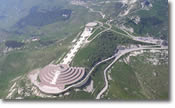 |
GEOMORPHOGRAPHICS.... Monte Grappa presents itself in two sections completely different, identified by a system of valleys, and even these valley's have different caracteristics, depending on which section of the mountain they are present.
These sections are divided in:
 The Southern section of the mountain, including the peak. Morphologically presents a structure similar to a high-plain in the way it is surrounded by high and steep escarpments, including the Valle di Santa Felicita and that of the Valle del Lastego. Both of these are made up of a narrow valley floor and they widen out as they rise towards the valleys modelled by the ancient glaciers. Caracteristics of the Southern section of the mountain include the variety of the topology and the fields located at higher altitudes. The Southern section of the mountain, including the peak. Morphologically presents a structure similar to a high-plain in the way it is surrounded by high and steep escarpments, including the Valle di Santa Felicita and that of the Valle del Lastego. Both of these are made up of a narrow valley floor and they widen out as they rise towards the valleys modelled by the ancient glaciers. Caracteristics of the Southern section of the mountain include the variety of the topology and the fields located at higher altitudes.
 The Northern section with a morphology completely different to the Southern section in the way that, other than offering a forest-based fauna and of cliff-faces similar to those of the Dolomites, it is modelled on a system of ridges that have a differing shape to that of the top of the mountain. The valleys present on this side of the mountain are nearly all river valley's, for example the Val Cesina, which feeds into the river Brenta, the Val Stizon which feeds the river Sonna, feeding the river Piave, the Valle delle Mure (river Calcino) and the Valle del Tegorzo The Northern section with a morphology completely different to the Southern section in the way that, other than offering a forest-based fauna and of cliff-faces similar to those of the Dolomites, it is modelled on a system of ridges that have a differing shape to that of the top of the mountain. The valleys present on this side of the mountain are nearly all river valley's, for example the Val Cesina, which feeds into the river Brenta, the Val Stizon which feeds the river Sonna, feeding the river Piave, the Valle delle Mure (river Calcino) and the Valle del Tegorzo
The mineral deposits tipical of the mountain are dolomite, calcium and red ammonite.
Situated on the borders of the provinces of Vicenza, Treviso and Belluno, is the highest mountain located in the Veneto Prealpi region.
Bordered by the flat plains on the south, the Valsugana to west, the river Piave to the east, the valley Feltrina and the Corlo lake to the north, it is well separated from the nearby mountain systems, with it's peak height at 1775m above sea level. It is famous for its sacred ossuary built to remember the bloody battles fought on the mountain during the first world war. |


